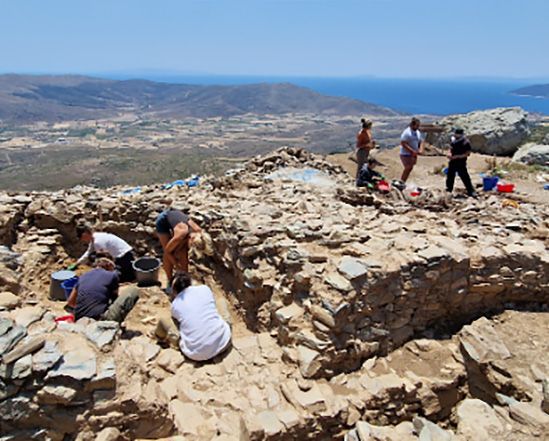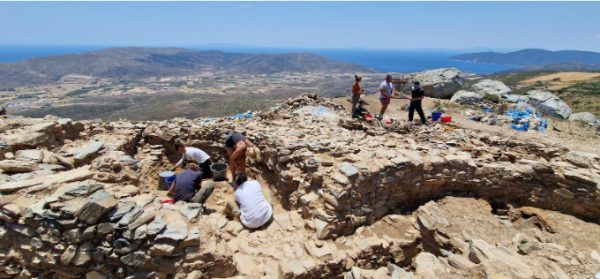
Excavating Prehistory on an Aegean Island: The Gourimadi Archaeological Project

IMPORTANT: The dates for this excavation are: June 2-29, 2024
NOTE: This course starts on June 2 and ends on June 29 in the city of Karystos on the island of Evia, Greece. Students should arrange to arrive in Athens the day before the start of the program, and to depart from Athens the day after the end of the program, in order to have time for their ferry connections between Athens and Karystos.
At a Glance
This course will take place as part of the Gourimadi Archaeological Project (GAP), an international prehistoric research excavation on the southern tip of the Aegean island of Euboea (modern Evia). The course is designed to provide an advanced archaeological field experience to undergraduate students, as well as a theoretical and methodological background regarding excavation techniques and Aegean Archaeology. The course will introduce the students to modern excavation, recording, and documentation methods, and the knowledge gained will translate well in other areas of the world and time periods.
Learning Outcomes:
Upon successful completion of both the fieldwork (8 AM – 3 PM) and class lecture (one-hour sessions on weekdays, 7 PM) sections of the course, the students will have learned how to:
- stratigraphically excavate an archaeological site;
- document their own excavation units in writing and sketch drawings;
- create Harris matrices of their own trenches;
- analyze architectural remains;
- fly a drone to obtain aerial imagery and orthomaps of an archaeological site;
- create photogrammetrical 3D models of trenches and small finds, using a DSLR camera;
- process small finds and ceramics in the project apothiki (storeroom/lab);
- carry out floatation in order to collect archaeobotanical finds;
- set up a total station and use it for spatial documentation.
In addition to these practical skills, they will also acquire academic knowledge on:
- excavation methodologies;
- remote-sensing techniques;
- history of archaeological documentation;
- Aegean prehistory from the Palaeolithic to the end of the Bronze Age;
- GIS applications in archaeological excavations and surveys;
- archaeobotany and other disciplines of archaeological sciences;
- introductory pottery and small finds illustration.
Gourimadi Archaeological Project (GAP)
Gourimadi Archaeological Project (GAP) includes the systematic excavation of a Late Neolithic – Early Bronze Age site near Karystos in Southern Euboea. The project is organized by the Norwegian Institute at Athens and conducted under a permit from the Greek Ministry of Culture and Tourism with the supervision of the Ephorate of Antiquities of Euboea. GAP is directed by Dr. Žarko Tankosić and co-directed by Drs. Fanis Mavridis and Paschalis Zafeiriadis.

The site of Gourimadi, meaning “Big Rock” in the local Arvanitiki language, lies on the outskirts of the Katsaronio plain, about 6 km from the modern town of Karystos in southern Euboea.
The prehistoric habitation extended over a natural hill with excellent defensive properties and a key position in the local landscape, which offered unobstructed vistas not only of its immediate surroundings but also of the neighboring regions of eastern Attica and the northern Cyclades (Andros, Tinos, Mykonos, Giaros, and Kea).

The projects aims to investigate the earliest farmers in southern Euboea, who may have played an important role in the eventual colonization of the central Aegean islands. As a multi-period site, spanning as much as two and a half millennia, from Late Neolithic to Early Bronze Age, Gourimadi will also play a crucial role in our understanding of the transition to the age of metals. Its peculiar location in the local topography, hundreds of arrowheads found during excavations, and its enigmatic architecture all indicate a special function for the site, as opposed to an ordinary farming village. Adobe (earthen) architecture attested in some of our deepest trenches is likely to be the earliest found in the region.

Methodology
The methodology employed in GAP is based on the removal of stratigraphic units (termed ‘excavation units’) which wherever possible correspond to natural and anthropogenic episodes of archaeological deposition. For faster and more precise measurements, a Total Station device is used throughout the excavation procedure (planning, excavating, and recording), including all elevation points taken for moveable artifacts, architectural features, and excavated units. All the excavated soil is dry-sieved and standardized flotation samples were systematically collected from each excavation unit. All written recording (excavated units and their specifications, unearthed features, all artifactual categories, coordinates) is paperless and is logged in a customized digital database using iPads on the field. The visual recording includes hand-drawn sketches and photogrammetrical 3D models of excavation units, and drone-based 3D modelling of the entire excavation area. The spatial information is integrated and analyzed in the project GIS. By the end of the project, the CYA students will be familiar with all of these aspects of an archaeological excavation.
Enrollment
This course requires a minimum enrollment of 10, with a maximum enrollment of 15.
Currently registered undergraduates majoring in relevant subjects will receive priority, as will applicants with a B+ average or above. The nature of the course is primarily introductory, but students with a stronger background in archaeology will have the opportunity to do more advanced work.
Credit
60 contact hours
Essential Information
The course starts and ends in Karystos, a town on the southern part of the island of Evia. Participants should arrange ferry passage from the port of Rafina to Marmari, the port of Karystos. They must make sure to arrive in Marmari by 3:00 p.m. on Sunday, June 2, where they will be met and transferred to their hotel, Anemomylos Bungalows, in Karystos. At the end of the course, participants should allow themselves time to return from Marmari to Rafina/Athens and should not plan to fly out of Greece earlier than June 30. The port of Rafina is the closest port to the Athens airport.
Enrolled students will have access to detailed information prior to departure that will include directions to the port of Marmari, and other practical information. For a general introduction to the island of Evia, including ferry connections from the port of Rafina, CYA suggests the following websites: https://www.visitgreece.gr/islands/evia/karystos/ , https://www.greektravel.com/greekislands/evia/karystos/index.htm and https://www.in-karystos.gr/indexenglish.html
Housing & Meals
Students will be accommodated at Anemomylos Bungalows, in the outskirts of Karystos.
Basic food supplies will be provided for students to make their own breakfast and lunch. Dinner will be offered Monday through Saturday at the hotel or at local tavernas. Please note that the dinner options will be regular or vegetarian only. No other dietary options can be accommodated.
Daily Schedule
Please keep in mind that excavation work is physically demanding and requires a total commitment of time and energy. Every morning at 7:00 a.m, Monday through Friday, your group will be transferred by chartered shuttle bus to the excavation site of Gourimadi where you will remain until 2:00-3:00 p.m. with a brief break in-between. You should be prepared to spend this time under the sun and in relatively high temperatures. Class meetings will take place in the early evening.
Sunday, June 2, 2024,
3:00 p.m.: Shuttle bus transfer from the port of Marmari to Karystos. Check in at Anemomylos Bungalows. Welcome and orientation session, offering students the opportunity to get acquainted with their instructor and fellow students.
Starting Monday, June 3:
7:00 a.m.: Daily shuttle bus transport to the Gourimadi excavation site (included in the course fee).
Students will be provided with basic excavation tools upon arrival at the excavation site; in addition they are advised to bring with them the following:
- Hat with wide brim
- Sun Block
- T-shirts covering the shoulders
- Sturdy shoes or closed shoes (NO sandals on the excavation)
- Long trousers – to avoid injuries & scratches from plants
- Garden Gloves, if you wish to bring your own (you will be given a pair at the excavation)
Each day you are at the excavation, you are advised to bring with you a bottle of water and a substantial snack.
12:00 – 12:30 p.m. Lunch break (prepare & bring your own lunch/snacks)
2:00 -3:00 p.m.: Return by shuttle bus to the hotel.
7:00 p.m.: Class meetings/lectures/projects.
8:00 p.m.: Dinner at the hotel or local tavernas.
Friday, June 28:
Last day of program
Saturday, June 29:
Check out of the Hotel by 11:00 a.m.
Day-to-day Program & Itinerary
The day-to-day program and itinerary of the course are subject to change.
![]()




